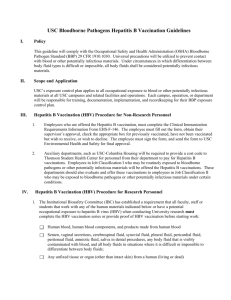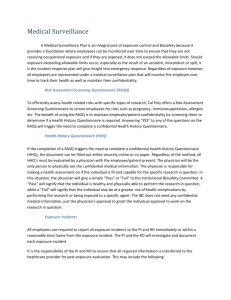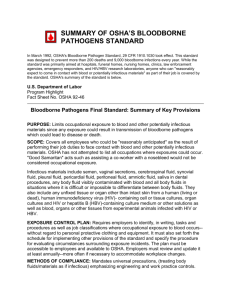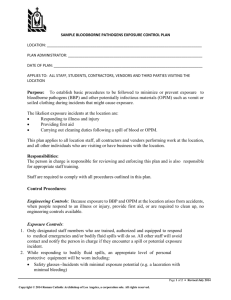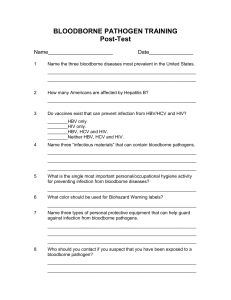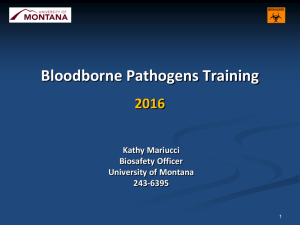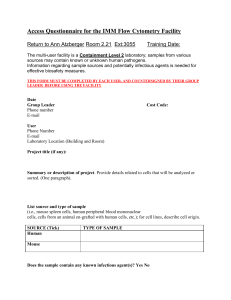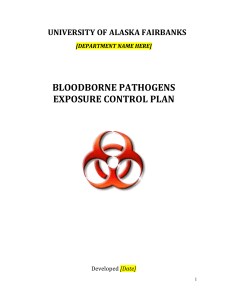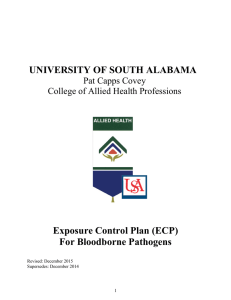Components of the Program
advertisement
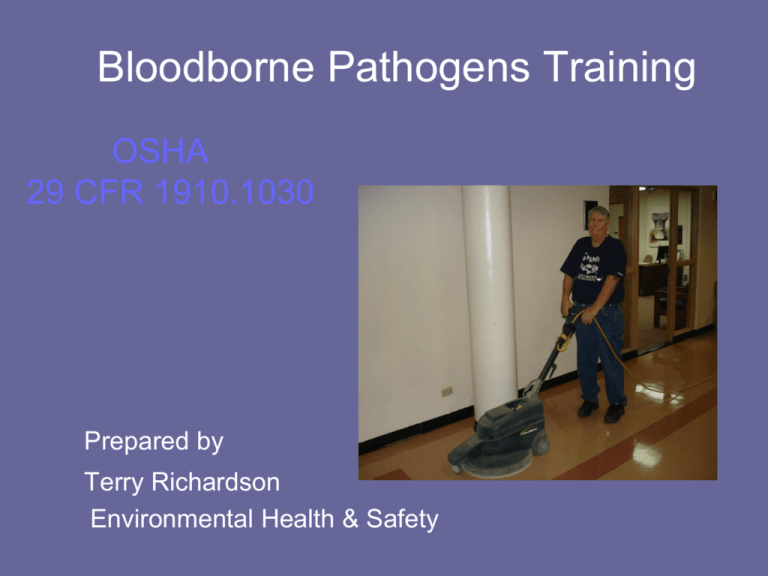
Bloodborne Pathogens Training OSHA 29 CFR 1910.1030 Prepared by Terry Richardson Environmental Health & Safety Agenda Topics • • • • • • What is a bloodborne pathogen? How can you be exposed to BBPs? How can you protect yourself? What should you do if you are exposed? OSHA Regulations Questions & Answers What is a Bloodborne Pathogen? • Any disease causing organism that is present in human blood or other potentially infectious material that can infect & cause disease in persons exposed to fluids containing that organism. Examples: • HIV, Hepatitis B & C, Malaria, Syphilis, Brucellosis, Viral Hemorrhagic fever What is a Bloodborne Pathogen? Hepatitis: • Causes an inflammation of the liver. • HBV can survive outside the body for 7 days and still be infectious HIV: • Disables the immune system and causes AIDS. • Will only survive outside the body for a few minutes What fluids transmit BBPs? • Fluids directly linked to transmission – blood, blood products – semen & vaginal secretions – internal body fluids – cultures containing bloodborne pathogens What fluids transmit BBPs? • ONLY when containing visible blood: – feces – nasal secretions – spit/mucous – sweat – tears – urine – vomit Why is this Important? There is no cure for most of the following: • HIV • Hepatitis B • Most of the remaining BBPs How can you be exposed to BBPs? • Contact with blood or infectious body fluids through: – Broken skin – Mucous membranes (eyes, nose, mouth) – Saliva injected from a bite can also transmit HBV – Needle sticks How can you Protect Yourself? • Follow General Safety Practices • Use Equipment Properly • Use Personal Protective equipment (PPE) such as gloves, goggles, coveralls, etc. • Use Universal Precautions • Vaccinate against HBV Universal Precautions • Treat all blood, bodily fluids, excretions, etc. as if they were infectious. • Always wear gloves when handling any material and use other PPE as needed. • • • • Universal Precautions includes: Hand Washing Environmental Control PPE Disinfection Spill Clean-Up : Basic Procedures • Restrict access to the space • Contact supervisor or emergency responders, if necessary • Locate spill kit or cleaning supplies • Put on PPE • Spray spill with disinfectant – Envirox Product 117 – Wipe-up most of the spill • Spray the spill area with disinfectant Spill Clean-Up : Basic Procedures • Leave disinfectant on the spill at least 10 minutes • Clean from outside of spill towards center of spill • Dispose of soiled materials in Biohazard bag – Material used for cleanup is infectious waste • Remove contaminated PPE, gloves last. • Wash hands after removing gloves If You Become Exposed • Exposure through broken skin or needle stick: immediately wash the exposed area with soap and water • Exposure through eyes, nose, mouth: flush exposed area quickly and thoroughly with water • Then: – Report exposure to your supervisor – Inform Human Resources to document exposure and to obtain a list of approved medical providers – Seek medical attention OSHA BBP Rule Required Elements: • Exposure determination – Which employees have occupational exposure? • Control methods – Universal precautions – Engineering controls – Work practice controls • Personal protective equipment OSHA BBP Rule • • • • • • • • HBV vaccination Post-exposure evaluation and follow-up Infectious waste disposal Tags, labels, and bags Housekeeping Practices Laundry practices Training and education of employees Recordkeeping Written Program • Fort Lewis College has a written program • Copy available online or in the EH&S office • Must be Updated Annually with Documentation – Exposure Determination – Input by NonManagement Employees with Potential BBP Exposure Control Methods: Engineering Controls •Controls that isolate or remove the BBP hazard from the workplace •Preferred method • Examples: – Puncture-resistant sharps containers – Splash guards Control Methods: Work Practice Controls • Controls that reduce the likelihood of exposure by altering the means in which a task is performed • Examples: – Hand Washing – Remove PPE When Leaving the Work Area – Proper PPE Storage, Decontamination and Disposal – Minimize Splashing and Spraying Control Methods: Personal Protective Equipment • Specialized clothing or equipment worn by an employee for protection against a hazard – Employers shall provide and ensure employee use – Variety of sizes – Readily accessible – No cost to employees Control Methods: Personal Protective Equipment – The department provides cleaning, laundering, or disposal of PPE – Repair or replace as required – Examples: • gloves, aprons, and head and foot coverings • face shields and eye protection – PPE selected for each task • Allergies must be considered • EHS can assist with this process Control Methods: Housekeeping Practices – Employer must ensure worksite is clean & sanitary – Clean-up and disinfection practices – Contaminated equipment – Specific Laundry Practices – Hand washing sinks are readily available as are emergency showers Infectious Waste Disposal • Applicable federal, state, and local regulations • Infectious Waste Management Program – Storage location in Student Health Center – Process is managed by the Student Health Center Infectious Waste Disposal • Place waste in sealed, leakproof containers or bags • Double bag if necessary • Containers must be color-coded red, labeled or tagged • Waste for pick-up must be placed in a container provided by Stericycle. • Never place red bags in the trash! Communication of Hazards • Biohazard symbol • Labels and tags • Biohazard bags Training and Education of Employees • Required initially – annually thereafter • Cover required topics – General training – Site-specific training • Q&A • Keep records Recordkeeping • Medical records kept for duration of employment plus 30 years – May include: • Sharps injuries • HBV and HIV illnesses from an exposure incident • Post exposure follow up medical opinions • Training Records (kept 3 years) • Annual program review (including new device evaluations) HBV Vaccination • HBV vaccination offered at no cost to all employees who are at risk for exposure to blood borne pathogens – Safe and effective – Training first, before vaccination decisions • Documenting refusals – Declination Form HBV Vaccine • Three injections in arm over a six month basis • More than 90% of those vaccinated will develop immunity • There is an antibody test for existing immunity • More details from the occupational health nurse Declination Statement I understand that due to my occupational exposure to blood or other potentially infectious materials I may be at risk of acquiring hepatitis B virus (HBV) infection. I have been given the opportunity to be vaccinated with hepatitis B vaccine, at no charge to myself. However, I decline hepatitis B vaccination at this time. I understand that by declining this vaccine, I continue to be at risk of acquiring hepatitis B, a serious disease. If in the future I continue to have occupational exposure to blood or other potentially infectious materials and I want to be vaccinated with hepatitis B vaccine, I can receive the vaccination series at no charge to me. Post-Exposure Evaluation and Follow-up • Exposure Incident – means a specific eye, mouth, other mucous membrane, non-intact skin, or skin-puncture contact with blood or other potentially infectious materials that results from the performance of an employee's duties Post-Exposure Evaluation and Follow-up Employees experiencing a possible exposure should wash the exposed area first. Report the exposure to your immediate supervisor and then, Call Human Resources to document the exposure and select one of our approved physicians to schedule an appointment. Post-Exposure Medical Follow-up • Confidential Medical Evaluation – Document route of exposure, circumstances – Status of source patient • Their blood tested if possible – Exposed worker blood tested, usually: • Immediately • Six-weeks post-exposure • Periodic basis thereafter (12-weeks, and 6 months after exposure) – Receives any necessary medical treatment – Counseling – Personal physician will treat our Information to Healthcare Provider • Employer must give to the healthcare provider: – A copy of the BBP Standard – Employee’s job duties and circumstances of exposure – Any blood results known – Any relevant medical information or vaccination status known Healthcare Provider’s Response • Written opinion within 15 days – Vaccination status and recommendations – That appropriate care is being received – The employee has been informed of findings and follow-up • All other findings and medical information are confidential Questions? Contact: Connie Kane RN Student Health Center 247-7355 Terry Richardson Environmental Health & Safety Berndt Hall 290 247-7272 www.fortlewis.edu/ehs
